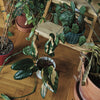How to prepare for the new season or Spring is just around the corner!

On March 20, the first spring day of 2022 awaits us, and not only maids are slowly starting to wake up to life. If your hands are already itchy, you are nervously looking through the collection of houseplants and you would like to start transplanting them, we have some tips for you, what else will benefit your plants in the spring.
You certainly do many of these recommended tips normally, but at the beginning of spring, plants need a little more complex care. The next growing season awaits them and they need a lot of nutrients, space, and some species will certainly appreciate trimming and adjusting their shape so that they still look good next year.
Cleanliness is half health
You can start preparing for spring, for example, by preparing all your growing and transplanting tools and giving them a thorough cleaning. Diseases and pests of plants are transmitted through contact and insufficient hygiene, just like in humans. Wash the pots in which you plan to transplant from the remains of the substrate and this will also remove any eggs or larvae of pests. You should clean your pruning shears and transplanting blades after every use (especially between plants), but if you can never bring yourself to do it, like me (horror!), at least give them a good wash and clean in the spring.
Speed dating or 2 minutes with each maid
Do you know speed dating? It's a special evening where singles are supposed to get to know each other in a few minutes and then the couples take turns. Try a similar event with your maids! Enjoy speed dating your plants before spring is in full swing and you stress about not having time to transplant them all.
"I have to admit that I speed date with my plants at least once a week. I look at them from all sides, pick up the leaves and yes, I also talk to them and I'm not ashamed of it! It also has a scientific justification, the carbon dioxide I exhaled will then be used for photosynthesis and subsequent growth. Well isn't that great? And it's also a very calming activity, thanks to which I can also detect pests in the beginning.'' - Bětka -
Take each one in your hand, examine it carefully and check how it coped with the winter season. Does one have ugly or yellow or withered leaves ? Are there any pests on the underside of the leaves or on the surface of the substrate? What about the roots , is the pot filled with them? Or do they even grow out of the drain holes? In this way, you can divide the plants according to the care they will need, and then do the more time-consuming steps at once. You can start with light maintenance right away, you can leave repotting until you have inspected them all and prepared a quality substrate and new, larger pots to repot into.

Spring haircut
Perhaps you also saved individual yellowing leaves in the winter in vain and counted how many viable ones are still there. In spring, however, it's the other way around. Find the strength within yourself and trim the plants that need it. You can multiply or cut more!
"I personally like propagating in water the most. I cut the plant, put it in a glass with water and a drop of lignohumate and that's it. Then I just observe how small roots form and when there are enough of them, I plant them back in the soil.''- Bětka -
Don't be afraid to trim your climbing plants or epipremnum, scindapsus trimming will also certainly appreciate all overgrown philodendrons , syngonias and monsters .
Also clean the leaves of the plants from dust with a damp cloth or sprayer. Or try using special wet wipes , which will form an antistatic coating on the leaves (and thus save you the work of frequent wiping in the future), at the same time partially nourishing the leaves thanks to the fertilizer content.
If you really want to thoroughly clean your maids, put them straight in the shower . But keep in mind that the water will reach the roots as well, so watch out for overwatering! Maybe it's better to wait until spring is in a more advanced stage and the plant can handle the excess water.

New energy from a new substrate
Those who buy plants from our e-shop have the advantage that they do not have to transplant the plants immediately. We will transplant them for you! It will definitely last at least a year like this. But when growing older plants, give them a spring transplant if they require one. Again, you can tell by a pot full of roots, or when the roots even grow out of the drain holes. For younger plants that are not so strongly rooted, you can replace only the top layer of the substrate in the spring.
Prepare a flower pot , clean and one to two (for very mature plants) larger , suitable substrate according to the type of plant and material for a drainage layer , for example expanded clay , which you will put under the flower pot to prevent rotting of the roots. For drought-loving plants, use a substrate for succulents , for plants from the aronaceae family (monsters, philodendrons, aglaonemas, epipremnum, scindapsus, ...) a special substrate for aroids is great, and for other plants you can use a classic substrate that we prepare for you ourselves.
Enough dressing
During the winter months, we warned you in our article to water the plants carefully and less frequently. This changes with the arrival of spring, as the days begin to lengthen and the first rays of spring warm the air. You will see that your houseplants will start to grow and will require more abundant watering . Always respect the requirements of individual plant species and water correctly , e.g. water succulents lightly even during the growing season, wait for the substrate to dry for sansevierias , etc. Once in a while, add fertilizer to the watering so that the plant has enough nutrients. Only a few weeks after transplanting into the new substrate, do not fertilize, because the substrates are often enriched with fertilizer and you could burn the roots with an excess of nutrients in good faith.
New location
The plant is washed, trimmed, transplanted, and now where to go with it? Before you return it to its original place, think about whether it will suit you during the spring and summer months. You probably moved most of your plants as close to a window as possible before winter so that they can receive plenty of light. But some species cannot stay in such a place forever! You must not forget to move shade- loving plants or those that cannot stand direct sunlight to another more suitable place.
Most houseplants love to overwinter , so if you have the chance, take them outside! Find them a spot with indirect sun that will be protected from major weather fluctuations and they will literally grow before your eyes. Give the plants enough time to adapt, for about the first 14 days you can bring them back inside at night. Because it is not called summering for nothing, there is really no time for such a move until the late spring months or almost at the beginning of summer, when the temperatures do not drop too deeply at night.
So, are you also looking forward to the start of the new growing season? I wish you much success not only in spring care!
Do you have a question? write to us in the comments, we will be happy to advise you not only with spring preparation but also with pests.
Author: Ing. Elizabeth Lacinová
-
Posted in
Zajímavosti a tipy




